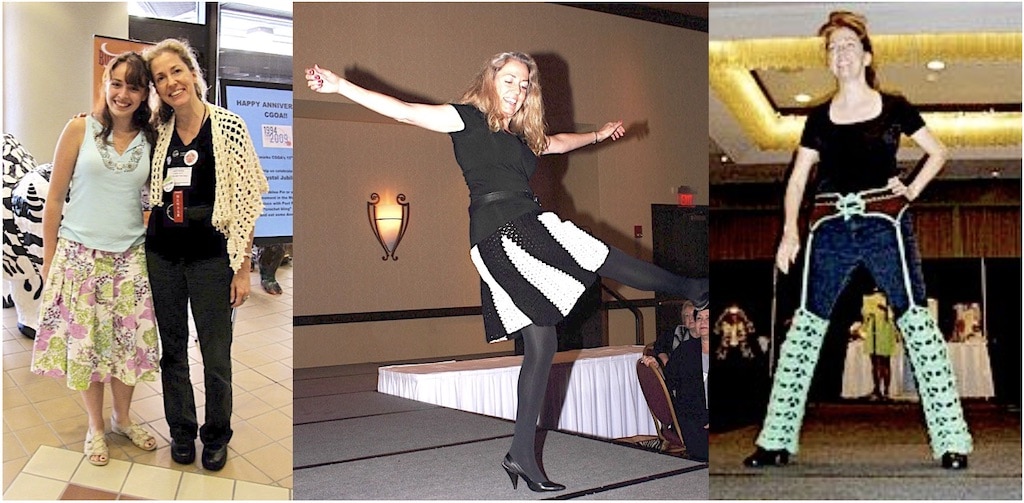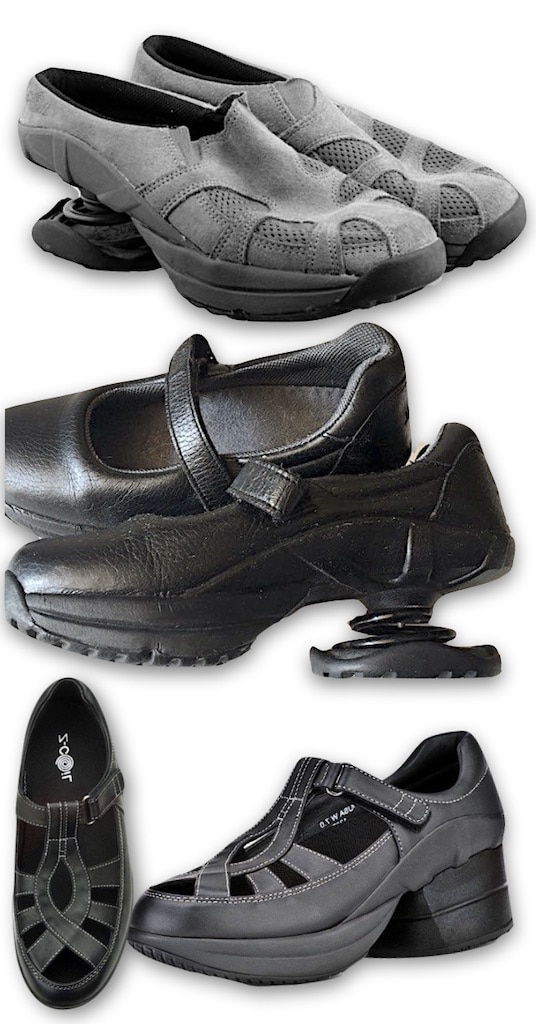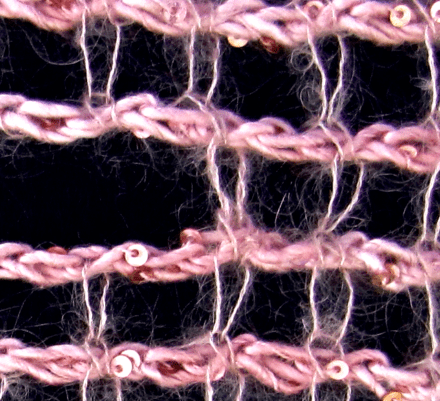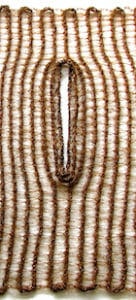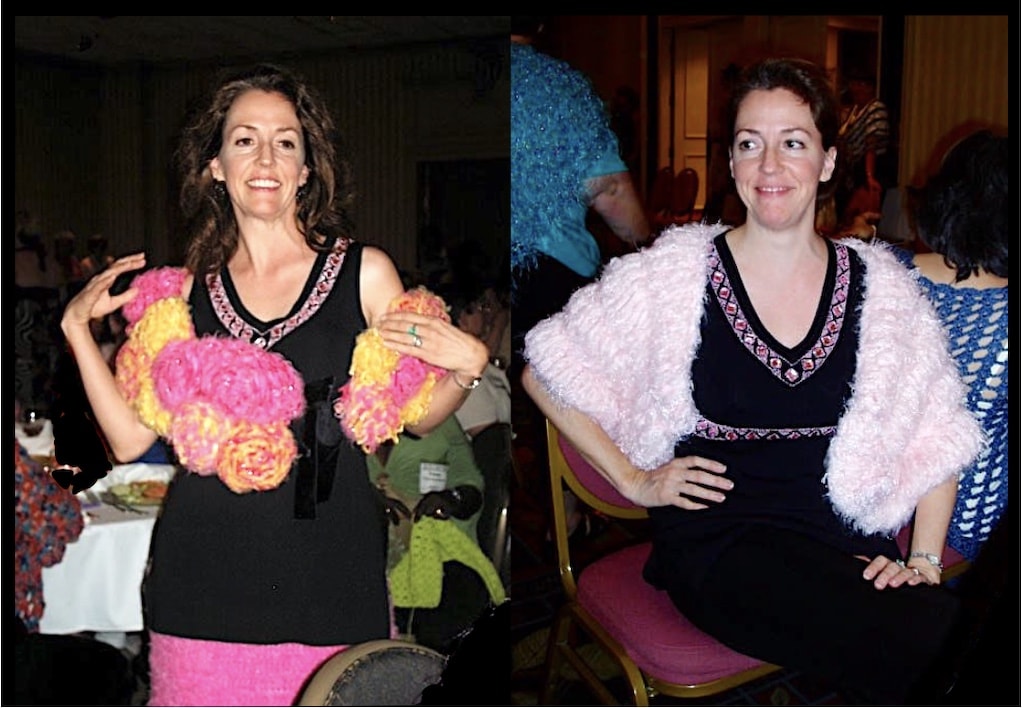
Updated August 7, 2020.
Pictured above: two views of my favorite top, dating from 2006-2008. I wore it to the evening banquets until I wore it out! On the left I’m modeling the Giant Roses Wrap and Smart Set With Swing skirt for Crochet! magazine, January 2007 issue. On the right is the Spun Sugar Cocoon in the 2006 book New Ideas for Today’s Crochet by Jean Leinhauser & Rita Weiss [link goes to my project page for it in Ravelry].
Conference Clothes to Pack
I’ve re-committed to the Z-CoiL® shoes so now I can focus on the conference clothes. At home in Florida I wear jeans and light-colored t-shirts (with or without Z-Coils). For the past 25 crochet conferences I’ve packed almost no jeans or t-shirts.
Lots of crochet conference attendees wear their most comfortable jeans, t-shirts, and sneakers and that’s great! That’s the easiest packing of all. (People do tend to dress up for the Saturday night banquet.)
Please don’t let what I’m about to say worry you if you’re a first-timer and you want to wear t-shirts and jeans! My choices are based on how I want to wear my crochet designs, and on all the professional, organizational, and event roles I play. (Designer, teacher, presenter, model, director, officer, etc.) So, ideally my conference clothes meet several needs at once.
Tops That Work
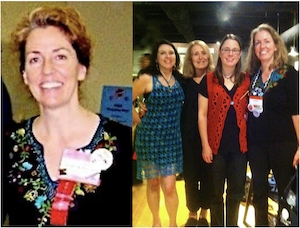
“Travelers” fabric so it always looked and felt great.
For these reasons the tops I pack are mostly plain stretchy black (or other neutral color), with different sleeve lengths and neckline styles. You can see many of them in the photos further down.
The best conference tops work great under a striking crochet vest, wrap, or cardigan and:
- are made of a breathable material that travels well
- look stylish enough
- work for both daytime and evening
- don’t hold on to shedding yarn fibers!
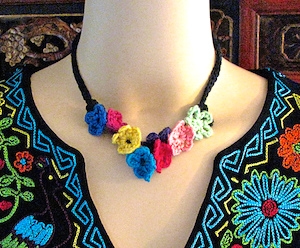
These tops are perfect for modeling and I pack extras for attendees who didn’t plan to model on banquet night. Other neutral colors can work too, like charcoal, navy, tan. I had a favorite conference top in charcoal. Still trying to find its replacement.
It’s surprising how hard it is for me to find simple classic conference clothes like these in neutral colors other than black. I think people don’t want to look at a lot of black all the time in crochet classes.
Nowadays for teaching I look for softly colored breezy tunics to wear.
Tops for Crochet Activism
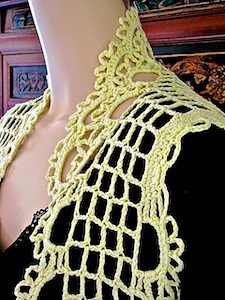
very visible at a knit-centric event.
When I want the maximum spotlight on a crocheted garment, I wear it over black. There’s just no better background and frame for crochet textures and colors. It really makes the crochet pop from a distance, such as a fashion runway.
Crochet activists know that we need in-your-face crochet magnificence that pops even across a city-block-long convention center walkway. Why?
Non-CGOA yarn industry events have long been knit-centric. You betcha I’ve brought all the inkiest-black clothing to wear under high-contrast crochet. I’ve watched people lock eyes on it a block away. I blogged more about the Crochet-In and other crochet activism we’ve done out of exasperation with the sidelining.
The Bottom Half
Good decisions about conference clothes depend on the level of air conditioning in the hotel, and in conference center rooms. It can fluctuate dramatically from room to room and by time of day. Crocheted shawls won’t keep my ankles from freezing.
Pants: I look for the same qualities as in tops. Additionally, I love a wide waistband that sits a bit below my waist. A long boot cut in a structured fabric looks best with the Z-Coils. I have a clear picture of what works the best for me, but sometimes I have to shop too much to find it.
Skirts and dresses can work for evenings. (Few look good with Z-Coils for daytime). A pair of semi-sheer black pantyhose/tights has often come in handy when I’m asked to model a skirt or dress for the banquet fashion show. For example, I wore them under the crocheted pants I’m modeling, below. In yesterday’s post I’m wearing them with high heels to model Urmie’s kick-pleat skirt.
Five Kinds of Belts?
Not all at one conference! The photos below span many years. I’m normally not a belt wearer, but…I wear a lot of things at conferences that I rarely wear at home.
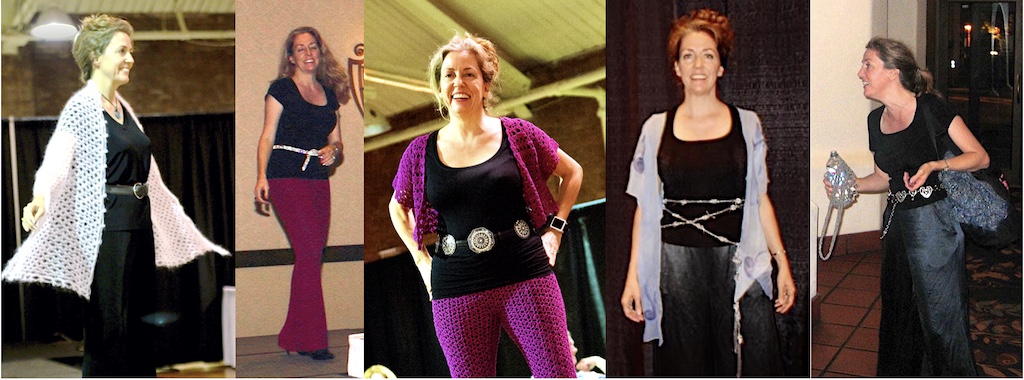
That’s the Weightless Tunisian Wrap on the far left. Then our own Lotus yarn in Grenadine that Doris crocheted into a Lotus Bolero and fitted pants. On the far right I’m toting Quencher and the free V-Stitch Cocoon Shrug.
Not everything goes with the shoes. Too bad! I won’t compromise there, despite my stylish friend Annie’s consternation. If ever there were a time when Z-CoiL® shoes are indispensable, this epic conference is it—the teaching (15 hours over 3.5 days), the show booth, and of course helping the Hall of Fame committee celebrate the wonderfulness that is Doris J. Chan!
Some years I get lucky with these brands: White House/Black Market, Ann Taylor, Chico’s. I found almost nothing I can use the other day, though—only capri pants, lovely skirts, and prints. I’m all ears if you have other brand suggestions for me.
By the way, I’ve also resumed editing and refining the class handouts now that my houseguest has left. We had a fantastic week rollerskating, tracking night blooming cereus, and visiting the mermaids of Weeki Wachee.
